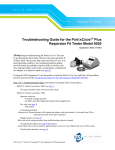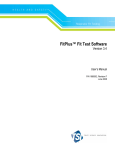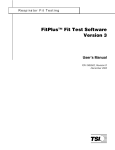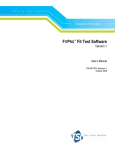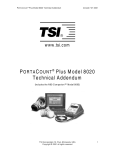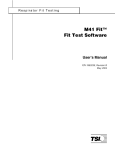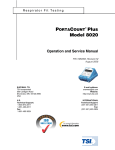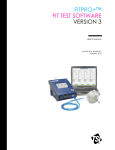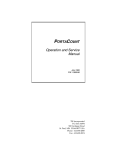Download N95-Companion Model 8095
Transcript
Respirator Fit Testing Model 8095 N95-Companion™ Mask Fit Tester to the PORTACOUNT® Plus Respirator Fit Tester Operation and Service Manual 1980308, Revision J January 2010 Copyright© TSI Incorporated / November 1997–2010 / Revision J / All rights reserved. Address TSI Incorporated / 500 Cardigan Road / Shoreview, MN 55126 / USA Fax No. (651) 490-3824 LIMITATION OF WARRANTY AND LIABILITY (effective July 2000) Seller warrants the goods sold hereunder, under normal use and service as described in the operator's manual, shall be free from defects in workmanship and material for (24) months, or the length of time specified in the operator's manual, from the date of shipment to the customer. This warranty period is inclusive of any statutory warranty. This limited warranty is subject to the following exclusions: a. Hot-wire or hot-film sensors used with research anemometers, and certain other components when indicated in specifications, are warranted for 90 days from the date of shipment. b. Parts repaired or replaced as a result of repair services are warranted to be free from defects in workmanship and material, under normal use, for 90 days from the date of shipment. c. Seller does not provide any warranty on finished goods manufactured by others or on any fuses, batteries or other consumable materials. Only the original manufacturer's warranty applies. d. Unless specifically authorized in a separate writing by Seller, Seller makes no warranty with respect to, and shall have no liability in connection with, goods which are incorporated into other products or equipment, or which are modified by any person other than Seller. The foregoing is IN LIEU OF all other warranties and is subject to the LIMITATIONS stated herein. NO OTHER EXPRESS OR IMPLIED WARRANTY OF FITNESS FOR PARTICULAR PURPOSE OR MERCHANTABILITY IS MADE. TO THE EXTENT PERMITTED BY LAW, THE EXCLUSIVE REMEDY OF THE USER OR BUYER, AND THE LIMIT OF SELLER'S LIABILITY FOR ANY AND ALL LOSSES, INJURIES, OR DAMAGES CONCERNING THE GOODS (INCLUDING CLAIMS BASED ON CONTRACT, NEGLIGENCE, TORT, STRICT LIABILITY OR OTHERWISE) SHALL BE THE RETURN OF GOODS TO SELLER AND THE REFUND OF THE PURCHASE PRICE, OR, AT THE OPTION OF SELLER, THE REPAIR OR REPLACEMENT OF THE GOODS. IN NO EVENT SHALL SELLER BE LIABLE FOR ANY SPECIAL, CONSEQUENTIAL OR INCIDENTAL DAMAGES. SELLER SHALL NOT BE RESPONSIBLE FOR INSTALLATION, DISMANTLING OR REINSTALLATION COSTS OR CHARGES. No Action, regardless of form, may be brought against Seller more than 12 months after a cause of action has accrued. The goods returned under warranty to Seller's factory shall be at Buyer's risk of loss, and will be returned, if at all, at Seller's risk of loss. Buyer and all users are deemed to have accepted this LIMITATION OF WARRANTY AND LIABILITY, which contains the complete and exclusive limited warranty of Seller. This LIMITATION OF WARRANTY AND LIABILITY may not be amended, modified or its terms waived, except by writing signed by an Officer of Seller. Service Policy Knowing that inoperative or defective instruments are as detrimental to TSI as they are to our customers, our service policy is designed to give prompt attention to any problems. If any malfunction is discovered, please contact your nearest sales office or representative, or call TSI's Customer Service department at (800) 8742811 (USA) or (001 651) 490-2811 (International) or visit www.tsi.com. Patents N95-Companion is patented under U.S. Patent No. 6,125,845. Trademarks TSI, TSI logo, PORTACOUNT and N95-Companion are trademarks of TSI Inc. Tygon is a registered trademark of Norton Performance Plastics. Windows is a registered trademark of Microsoft Corporation. CONTENTS Safety Information ............................................................................. iii Chapters 1. Unpacking and Parts Identification ........................................... 1 Unpacking the N95-Companion™ Mask Fit Tester Kit .................. 1 Parts Identification for the N95-Companion™ Mask Fit Tester ..... 2 Replacement Parts and Supplies .................................................. 6 2. Setting Up the Model 8095 N95-Companion™ Mask Fit Tester ............................................................................................ 7 Introduction .................................................................................... 7 Selecting a Fit Testing Location .................................................... 7 Setting up the Model 8026 Particle Generator .............................. 8 Setting up the N95-Companion™ Mask Fit Tester........................ 9 Installing the Probe ...................................................................... 12 Switching the Hardware Configuration from the N95-Companion™ Mask Fit Tester to the PORTACOUNT® Plus Respirator Fit Tester ........................................................ 14 3. Fit Testing with the N95-Companion and the PORTACOUNT® Plus Respirator Fit Tester......................................................... 17 Introduction .................................................................................. 17 Fit Test Procedure ....................................................................... 17 4. Maintenance ............................................................................... 21 Overview...................................................................................... 21 Daily Checks................................................................................ 21 Periodic Maintenance .................................................................. 23 5. Troubleshooting ........................................................................ 33 A. Specifications ............................................................................ 37 Visit the TSI web site at www.tsi.com. i (This page intentionally left blank) ii SAFETY INFORMATION Although the supply voltage to the Model 8095 N95-Companion™ Mask Fit Tester is low-voltage, the instrument contains an internal high-voltage converter. To minimize the danger of shock, always unplug the instrument before removing the cover for maintenance or replacement of parts. Internal High Voltage Warning Label Warning Labels on bottom of N95-Companion™ Mask Fit Tester iii (This page intentionally left blank) iv Chapter 1 Unpacking and Parts Identification Unpacking the N95-Companion™ Mask Fit Tester Kit Carefully unpack the Model 8095 N95- Companion™ Mask Fit Tester and accessories from the carrying case. Use the tables and illustrations below to make certain that there are no missing components. Contact TSI immediately if anything is missing or damaged. Table 1-1: Model 8095 N95 Companion™ Mask Fit Tester Kit Component Parts Quantity 1 1 1 1 1 1 1 1 1 1 1 1 1 100 100 1 1 1 1 1 Item Description N95-Companion™ Mask Fit Tester Sampling pendant Pendant interconnect tube Pendant sample tube N95-Companion interconnect tube N95-Companion interconnect cable Water trap Model 8095 Operation and Service Manual Particle generator Particle generator power cord Package of 100 salt tablets Model 8026 Particle Generator Operation and Service Manual Probe insertion tool set (1 pair) Sample probes Push nuts Water trap sponge, extra PORTACOUNT® Technical Reference and FitPlusTM Fit Test software CD Neck strap Syringe, 10 cc 3” Tygon® tubing Part/Model 8095 801500 801502 801501 3900049 1303522 801503 1980308 8026 1303567 2918035 1980319 801549 n/a* n/a* n/a 1083506 2913124 n/a n/a *Reorder refill kit 8025-N95R which includes 500 sample probes and 500 push nuts Tygon® is a registered trademark of Norton Performance Plastics. 1 Parts Identification for the N95-Companion™ Mask Fit Tester Figures 1-1 through 1-9 identify the parts of the Model 8095 N95-Companion™ Mask Fit Tester. Please become familiar with these components before proceeding. Neck Strap Sampling Pendant PORTACOUNT® Plus Respirator Fit Tester N95-Companion™ Mask Fit Tester N95-Companion™ Fit Tester Interconnect Tube Water Trap Pendant Sample Tube Pendant Interconnect Tube Figure 1-1. N95-Companion™ Mask Fit Tester, PORTACOUNT® Plus Respirator Fit Tester, and Sampling Pendant 2 Chapter 1 Port and Connector to Sampling Pendant Port to PORTACOUNT® Plus Respirator Fit Tester Figure 1-2 Model 8095 N95-Companion™ Mask Fit Tester– Top Front View Connector for Factory Use Only Particle Classifier Check Button Connector to PORTACOUNT® Respirator Fit Tester Figure 1-3: Model 8095 N95-Companion™ Mask Fit Tester– Top Back View Unpacking and Parts Identification 3 Figure 1-4: Model 8095 N95-Companion™ Mask Fit Tester– Bottom View Figure 1-5: Model 8026 Particle Generator 4 Chapter 1 Figure 1-6: Sampling Pendant Probe Insertion Tools Sampling Probes Push Nuts Figure 1-7: N95 Probe Insertion Kit Unpacking and Parts Identification 5 Pendant Interconnect Tube Pendant Sample Tube N95-Companion™ Fit Mask Tester Interconnect Tube N95- Companion™ Fit Mask Tester Interconnect Cable Figure 1-8: Tubes and Cables Figure 1-9: Salt Tablets Replacement Parts and Supplies The following items are sold by TSI as replacement parts and supplies for the Model 8095 N95-Companion™ Fit Mask Tester. Table 1-2: Replacement Parts and Supplies Quantity Item Description 1 Sample probe refill kit: includes 500 sample probes and 500 push nuts 1 package Salt tablets (100 each) 6 Part/Model 8025-N95R 2918035 Chapter 1 Chapter 2 Setting Up the Model 8095 N95-Companion™ Mask Fit Tester Introduction Before you can begin fit testing with the PORTACOUNT® Plus Respirator Fit Tester and N95-Companion™ Mask Fit Tester, you must: • • • • Select a fit testing location Set up the particle generator Set up the instrument Insert the probe into the type of mask you wish to test You also must have the Model 8020 PORTACOUNT® Plus fit tester with the Revision A modification to use the N95-Companion™ fit tester. Look for “8020A” on serial number tag. Refer to the following instructions to complete the set-up procedures. Selecting a Fit Testing Location To obtain valid results using the N95-Companion™ fit tester with the PORTACOUNT® Plus fit tester for fit testing, you must conduct the fit tests in a suitable location while running the supplied Model 8026 Particle Generator. The N95-Companion™ fit tester uses a small portion of the room aerosol for fit testing. To obtain consistent and repeatable fit tests, TSI recommends that you operate the particle generator to supplement the naturally occurring room aerosol. For the generator to function properly, you must conduct the fit tests in an enclosed area. A medium-sized room is normally a suitable location. The particle generator does not function efficiently in an open area or a very large room. 7 Setting up the Model 8026 Particle Generator The purpose of the particle generator is to supplement the naturally occurring particles in the room environment. The N95-Companion™ fit tester requires a minimum count of 70 particles/cc to operate. The target is 100 to 300 particles/cc for optimal performance. Follow the steps below to set up the particle generator: 1. Fill the reservoir with clean tap water to the fill line. You may use hot water to help the salt tablet dissolve more quickly. 2. Drop one salt tablet into the reservoir. Each tablet contains 1.0 grams of salt. Break the tablet before dropping it into the water to dissolve it more quickly. 3. Place the temporary cover tightly on the reservoir and shake it gently to dissolve the salt tablet. 4. Once the tablet is dissolved, remove the temporary cover and screw the reservoir into the particle generator. 5. Place the particle generator at least five feet away from the N95Companion™ fit tester and PORTACOUNT® Plus fit tester. Make sure the ventilation louvers on the back and bottom of the generator are not obstructed, as this could cause the instrument to overheat. ! 6. Caution Do not place the particle generator on the table. The internal vibrations in the generator will cause it to move and eventually fall off the table. Locate the power cord and connect it to the particle generator and to a grounded wall outlet. Turn on the power to the generator. The power switch is located next to the power cord receptacle. You must run the particle generator in the testing room, with the door closed, for at least 15 minutes before you begin fit testing to allow the particle count to stabilize. You must operate the generator in an upright position at all times, and leave it running until all fit tests for the day are complete. One reservoir full of salt solution will last from 8 to 16 hours, depending on the generator setting. Refer to the Model 8026 Particle Generator Operations Manual for information on changing the output setting. 8 Chapter 2 You can save and reuse the solution if you wish. However, do not mix old solution with fresh solution. If you need to mix new solution, first discard whatever remains in the reservoir. If you wish to reuse solution, be sure to detach the reservoir from the generator, cover it tightly with the temporary cover, and store it in its designated space inside the carrying case. Never attempt to store the particle generator in the carrying case with a full or partially filled reservoir attached, as the solution will leak out and damage the generator. Setting up the N95-Companion™ Mask Fit Tester 1. If this is the first time you are setting up the instrument, remove the rubber plugs from the left and right sides of the PORTACOUNT® Plus Respirator Fit Tester to allow it to lock into place on top of the N95Companion™ Mask Fit Tester. Place the PORTACOUNT® Plus Respirator Fit Tester on top of the N95Companion™ case. When properly positioned, the PORTACOUNT® Plus Respirator Fit Tester will lock into place as the spring clips on the cover of the N95-Companion™ Mask Fit Tester connect with the base of the PORTACOUNT® Plus Respirator Fit Tester. Remove Rubber Plug Here 2. Attach the pendant sample tube, using the ends of the tube that are of equal lengths, to the sampling pendant. The tube barbs are color coded to the tubing colors (blue-to-blue and clear-to-clear). Setting up the Model 8095 N95-Companion™ Mask Fit Tester 9 Pendant Sample Tube Pendant Interconnect Tube 3. Attach the pendant interconnect tube to the sampling pendant. 4. Attach the water trap, using the supplied short tubing, to the N95Companion™ Mask Fit Tester sampling port. This is the left-most barbed fitting on the front of the N95-Companion™ Mask Fit Tester. 5. Attach the loose end of the pendant interconnect tube to the water trap. Short Tubing Water Trap 6. 10 Attach the cable connector to the N95-Companion™ Mask Fit Tester. Chapter 2 7. Connect the N95-Companion™ Mask Fit Tester to PORTACOUNT® Plus Respirator Fit Tester interconnect tube between the N95-Companion™ Mask Fit Tester output (the right-most barbed fitting on the front of the unit) and the PORTACOUNT® Plus Respirator Fit Tester sample input (marked "S" on the front of the PORTACOUNT® Plus Respirator Fit Tester). Interconnect Tube 8. Connect the N95-Companion™ Mask Fit Tester interconnect cable from the accessory port on the back of the PORTACOUNT® Plus Respirator Fit Tester to the matching port on the back of the N95-Companion™ Mask Fit Tester. The cable is the same on both ends. Interconnect Cable This Port For Factory Use Only Note: The black port on the back of the N95-Companion™ Mask Fit Tester is used for factory calibration only. Setting up the Model 8095 N95-Companion™ Mask Fit Tester 11 Installing the Probe 1. Select the mask you wish to test. 2. Slide the sampling probe onto the piercing tool. As the pointed end of the piercing tool is very sharp, be extremely careful when handling it! Sampling Probe 3. Choose a location on the mask that is in front of the person's nose/mouth region. Avoid seams and folds in the mask. 4. Pierce the mask at the selected location, using the piercing tool with the loaded sampling probe. Be sure to pierce the mask from the inside! Push Nut Positioned on Anvil Tool Sampling Probe Pushed Through Mask 12 Chapter 2 5. Push the sampling probe through the mask until the end of the tool point is visible from the outside of the mask. Leave a few millimeters of the tool point visible. 6. Place the push nut on the anvil tool with the "dished" side up. A magnet prevents the push nut from falling off. 7. Position the anvil tool, with the loaded push nut, over the protruding point. The mask should now be pinched between the two tools. 8. Press the two tools firmly together to force the push nut as far as possible onto the probe. The mask material should be tightly pinched and the mask, sampling probe, and push nut should be joined together as illustrated. Push the Tools Together to Fasten the Probes 9. Inspect the sampling probe to be sure it is not plugged. Try to rotate the probe with your fingers. If it moves freely, use the probe insertion tool kit to press the push nut firmly onto the sampling probe and pinch the mask material more tightly. Setting up the Model 8095 N95-Companion™ Mask Fit Tester 13 Note: Once you install a sampling probe into a disposable mask, the mask cannot be used for respiratory protection. Probed masks are to be used for quantitative fit testing only. Discard each probed disposable mask after a fit test is completed. Switching the Hardware Configuration from the N95Companion™ Mask Fit Tester to the PORTACOUNT® Plus Respirator Fit Tester The following steps describe how to convert from N95-Companion™ Mask Fit Tester fit testing mode to PORTACOUNT® Plus Fit Tester fit testing mode. 1. Disconnect the N95-Companion™ Mask Fit Tester interconnect cable from the back connector on the PORTACOUNT® Plus Fit Tester. N95-Companion™ Mask Fit Tester Interconnect Cable 14 Chapter 2 Note: If the PORTACOUNT® fit tester is turned on when the cable is disconnected, the PORTACOUNT® fit tester screen will go blank for several seconds, and then turn back on. This is normal. The PORTACOUNT® fit tester detects that the N95-Companion™ Mask Fit Tester is no longer connected and resets itself with new timing parameters. 2. Disconnect the pendant interconnect tube on the front of the N95Companion™ Mask Fit Tester. Pendant Interconnect Tube 3. Disconnect the N95-Companion™ Mask Fit Tester interconnect tube. N95-Companion™ Mask Fit Tester Interconnect Tube Setting up the Model 8095 N95-Companion™ Mask Fit Tester 15 4. If desired, detach the PORTACOUNT® fit tester from the N95Companion™ Mask Fit Tester. Using your thumbs, pull outward on the two spring clips located on the base of the PORTACOUNT® fit tester, while gently lifting the PORTACOUNT® fit tester up. 5. Attach the standard PORTACOUNT® fit tester twin-tube assembly to the blue and clear ports on the front of the PORTACOUNT® fit tester. The PORTACOUNT® fit tester is now ready for fit testing respirators with class 99 or class 100 filters. Standard ® PORTACOUNT Fit Tester Twin Tube Assembly 16 Chapter 2 Chapter 3 Fit Testing with the N95-Companion™ Mask Fit Tester and the PORTACOUNT® Plus Respirator Fit Tester Introduction Before you begin fit testing, during the time the particle generator is stabilizing the room environment, turn on the PORTACOUNT® Plus Respirator Fit Tester and allow it to warm up. Be sure to perform the daily checks! Refer to Chapter 4, Maintenance, for daily check instructions. If your fit test subject is a smoker, make sure that he or she has not smoked for at least half an hour before starting the fit test. Note: The N95-Companion™ Mask Fit Tester has no power supply of its own, but is powered by the PORTACOUNT® Plus Respirator Fit Tester. Because the N95-Companion™ Mask Fit Tester increases the load on the PORTACOUNT® Plus fit tester, use the AC adapter whenever possible for your power supply. If you choose to use the optional battery pack, be aware that the battery life is significantly reduced when it must supply power for both instruments. A maximum fit factor of 200 can be displayed when you use the N95Companion™ Mask Fit Tester and the PORTACOUNT® Plus fit tester together. If you require a higher fit factor, you must use the PORTACOUNT® Plus fit tester without the N95-Companion™ Fit Tester. Note: Fit testing of class 95 respirators requires the use of the N95Companion™ Mask Fit Tester. Class 99 and class 100 respirators should be fit tested with the PORTACOUNT® fit tester alone. Fit Test Procedure 1. Have the fit-test subject hang the N95-Companion™ Mask Fit Tester sampling pendant around his or her neck, adjusting the neck strap on the assembly to a comfortable position. Make sure the TSI logo label is facing outward. The sampling pendant should be positioned high enough so that the tubing does not pull the mask off the person’s face. 2. Attach the sampling tube (clear sample line) from the pendant to the mask sampling probe. Make sure you do this before the subject dons the mask. 17 3. Have the subject don the mask without assistance. Fit test results depend on the subject knowing how to properly don the mask. All subjects should be trained in proper mask-donning techniques before being fit tested. Do not allow the subject to adjust the mask during the exercises, as this invalidates previous results. 4. Start the FitPlus™ for Windows® fit test process. (If you are not using FitPlus™ for Windows® software, refer to the PORTACOUNT® Plus Respirator Fit Tester Operation Manual for alternate procedures. Also, only the basic fit test steps are provided here. Refer to the FitPlus™ Fit Test Software for Windows® online help for detailed information.) a. Select the test subject from the People database. Create a new record if necessary. Click NEXT. b. Select the respirator to be used from the Respirator database. Click NEXT. c. Type in the mask size, and check that the displayed pass/fail level and exercise protocol are correct. Click NEXT. d. Click START to begin the fit test. 18 Chapter 3 5. Have the test subject follow the exercises one after another when prompted by the software. Each exercise takes approximately 90 seconds to complete. When the test is complete, the overall fit factor is displayed on the screen. 6. Review the results. a. If the fit test passed, issue that exact size and model respirator to the test subject. b. 7. If the fit test failed, determine the reason and repeat the test. Some common reasons for failure are: incorrect mask size for test subject; cigarette smoking less than an hour before the test; incorrect mask donning technique. If you are fit testing with a disposable respirator, discard it when the fit test is complete. Probed respirators are intended for fit testing only and are never to be reused. You may be able to sanitize and reuse other types of respirators. Contact the respirator manufacturer for specific information. Fit Testing with the N95-Companion™ Mask Fit Tester and the PORTACOUNT® Plus Respirator Fit Tester 19 (This page intentionally left blank) 20 Chapter 3 Chapter 4 Maintenance Overview The N95-Companion™ Mask Fit Tester and PORTACOUNT® Plus Respirator Fit Tester both require daily and periodic maintenance. Refer to the PORTACOUNT® Plus Respirator Fit Tester Operation and Service Manual for PORTACOUNT® Plus Respirator Fit Tester maintenance information. The N95-Companion™ Mask Fit Tester maintenance information appears below. Daily Checks The daily checks are designed to determine if the instrument is working properly. They must be done in the order specified. There are four daily checks: • Particle check • Classifier check • Zero check • Maximum fit factor check Note: FitPlus™ for Windows® software can be used to automate the daily checks if desired. Performing the Particle Check After you set up the N95-Companion™ Mask Fit Tester and PORTACOUNT® Plus Respirator Fit Tester, run the particle generator for at least 15 minutes, touch the count switch on the PORTACOUNT® Plus Respirator Fit Tester. The concentration number will appear in the PORTACOUNT® Plus Respirator Fit Tester display. You must have a particle count of at least 70 to pass this test. Note: The N95-Companion™ Mask Fit Tester will not operate at concentrations below 70 particles per cc. Do not be concerned if concentrations are higher than 250 to 300 particles/cc. This may simply indicate a high concentration of naturally occurring aerosol. Also, if concentrations are this high, you may be able to operate the particle generator at a lower setting, or not at all. Refer to the Model 8026 Particle Generator Operation and Service Manual for more information. 21 Performing the Classifier Check After you perform the particle check with the PORTACOUNT® Plus Respirator Fit Tester still in the count mode, press and hold the classifier check button on the back of the N95-Companion™ Mask Fit Tester for a minimum of 15 seconds. This disables power to the particle classifier. The PORTACOUNT® Plus Respirator Fit Tester display should gradually return to a count of 0.0. This verifies that there are no leaks in the instrument and that the classifier is functioning properly. Classifier Check Button Note: Do not be concerned with an occasional 0.6 particle/cc reading. However, if the display reads 1.2 particles/cc or higher, you may need to return the N95-Companion™ Mask Fit Tester to TSI for servicing or repair. Refer to Chapter 5, “Troubleshooting,” for help in diagnosing the problem before you return the instrument to TSI. Performing the Zero Check Put the PORTACOUNT® fit tester in count mode. You should see a reading greater than 70 particles/cc. Attach the small HEPA filter provided with the PORTACOUNT® fit tester to the clear sample hose coming out of the sampling pendant. The particle count should drop to zero within 30 seconds to pass this test. An occasional reading of 0.6 is acceptable, but the display should read 0.0 most of the time. If a zero reading cannot be achieved, make sure all tubing is properly attached. Check for leaks where the tubing connects to a barb. Try a different filter or put two filters in-line if nothing else works. 22 Chapter 4 Performing the Maximum Fit Factor Check Make sure all previous checks have been completed successfully before proceeding. Put the PORTACOUNT® fit tester into fit test mode. If the small HEPA filter supplied with the PORTACOUNT® fit tester is not already attached to the sample hose coming out of the sampling pendant, attach it now. Do not proceed until the HEPA filter has been on the sample hose for at least 30 seconds. Start a fit test by pressing the Test Start/Stop key on the PORTACOUNT. This causes the instrument to do a fit test on the HEPA filter, thereby simulating a perfect respirator. The result should be a very high fit factor of at least 200. A fit factor of 200 is the highest number that can be displayed when N95-Companion™ Mask Fit Tester is in use. If the instrument is being used without software, the word “Fit Factor” will flash when a fit factor over 200 is computed. A value below 10 suggests that the switching valve inside the sampling pendant is stuck on the ambient side. See the chapter on maintenance. A “Low Particle Count” message indicates that the valve inside the sampling pendant is stuck on the sample (mask) side. See the chapter on maintenance. A value between 10 and 200 indicates a leak someplace in the system. Inspect all tubing and hose connections. Periodic Maintenance The following components of the N95-Companion™ Mask Fit Tester require periodic maintenance. • • • • Flexible tubing Pendant switching valve Water trap Particle classifier There are no other user-serviceable components inside the N95Companion™ Mask Fit Tester. Do not attempt to adjust any components except those described in this manual or you may invalidate your warranty. In addition to the procedures outlined below, TSI recommends annual factory service for the N95-Companion™ Mask Fit Tester. Maintenance 23 Pendant Switching Valve To perform the purging procedure, you will need these tools and supplies: • Small dish or cup of warm water • TSI purge kit 1. Assembling the valve purge kit: 2. 24 • Remove the cover from the syringe tip. • Press the 3” tube onto the syringe tip. Filling the valve purge syringe with water: • Fill the particle generator cup up to the line with warm water. • Draw a full syringe of water from the cup. Chapter 4 3. Preparing the fully assembled N95-Companion™ Mask Fit Tester for the purge procedure: • 4. Maintenance Disconnect the main air sample tube. To purge the mask sample side (silver connector), do the following: • Connect the valve purge syringe to the (now available) sample connector. • With the PORTACOUNT® fit tester and N95-Companion™ Mask Fit Tester turned off, force the entire contents through pendant, you will notice the mask sample side draining. 25 5. 26 To purge the ambient side (blue connector), do the following: • Refill the valve purge syringe with warm water and reconnect it to the pendant as before. • Turn on the PORTACOUNT® fit tester and N95Companion™ Mask Fit Tester. • After the PORTACOUNT® fit tester has completed the initial countdown, press “start/ test” and begin to force the entire contents through the pendant—you will notice the ambient side draining for the first 15 seconds followed by the mask side draining. Chapter 4 6. 7. 8. Clear the remaining moisture out of both sample sides with forced air: • The mask sample side can be done with the PORTACOUNT® fit tester and N95-Companion™ Mask Fit Tester turned off. • The ambient side must be done in the same sequence as described in step 5 for purging the valve. If either side did not appear to allow purge water to run freely: • Repeat steps 2 though 6. • If problems persist send the unit in for service. Re-assemble the N95-Companion™ Mask Fit Tester sample tube back onto the pendant as before, and discard the purge water. Note: Save the valve purge syringe for future use. 9. This procedure is intended to remove salt build-up from N95Companion™ Mask Fit Tester new and old style pendant valves (but not PORTACOUNT® fit tester) it is recommended that this procedure be done monthly or more often depending on frequency of use. Water Trap The water trap contains a sponge to absorb the condensation that occurs during fit testing. The trap requires very little maintenance under normal operating conditions. Maintenance 27 The transparent cover on the water trap allows you to visually inspect the condition of the sponge and the trap's interior. If you wish to clean the interior or clean/replace the sponge: 1. Remove the two screws that hold the cover in place and remove the cover, along with the gasket. Water Trap 2. Clean the trap and sponge with alcohol to sterilize them. 3. Dry the trap and sponge thoroughly before reassembling them to prevent the growth of molds. One extra sponge is included with the N95-Companion™ Mask Fit Tester. You can order additional sponges from TSI if necessary. Particle Classifier The particle classifier requires annual cleaning under normal usage conditions. TSI recommends that the N95-Companion™ Mask Fit Tester receive factory service each year. It is best (but not a requirement) to send the N95-Companion™ Mask Fit Tester and the PORTACOUNT® Plus Respirator Fit Tester to TSI at the same time so the two instruments can be checked out together. A problem that appears to be caused by the N95-Companion™ Mask Fit Tester may actually be caused by the PORTACOUNT® Plus Respirator Fit Tester. The cleaning procedure that follows should only be attempted in the event of an instrument malfunction. It is not a substitute for the recommended annual factory service. Low particle counts can be caused by a dirty particle classifier; however, there are several other possible causes that are much more 28 Chapter 4 likely and should be investigated first. Consult the chapter on troubleshooting for details. Note: The technician attempting this procedure must take special care to make certain that none of the internal tubes become pinched or blocked when the unit is reassembled. Pinched tubing is a common problem that will prevent the instrument from working properly after this procedure is completed. WARNING ! Be sure to disconnect the power supply before beginning this procedure to avoid the risk of electric shock. To clean the particle classifier: 1. Disconnect all tubes and cables from the N95-Companion™ Mask Fit Tester. Remove the top cover by removing the six screws underneath. 2. Examine the placement of the thumbscrew clamps on the particle classifier. The existing clamp locations are selfevident, due to the screw "scoring" marks on the top housing of the classifier. 3. Remove each of the three clamps in turn by loosening the thumbscrews and tilting the clamp until it slides off. Do not disconnect any tubing or wires. Thumbscrew Clamps Maintenance 29 4. Remove the silicone tubing from the top of the particle classifier. Silicone Tubing 5. With the clear tubing still attached, rotate the top housing up and out, to expose the inside of the particle classifier. Inside of the Particle Classifier 30 Chapter 4 6. Using a damp (not wet) lint-free cloth, gently wipe off the interior surfaces of the classifier, removing the accumulated dust particles. Clean Both Surfaces 7. Make sure the O-ring is properly positioned in the lower housing groove. O-ring in Proper Position Maintenance 31 8. Rotate the upper housing back into position. Note the correct orientation below. Correct Position of Upper Housing 9. Replace the three thumbscrew clamps in the original locations. Do not overtighten! (See step #2 for picture.) 10. Continue to tighten the thumbscrews, in sequence, until they are finger-tight. Be careful not to tighten any one screw excessively, as this may cause the cover to twist and produce a leak. 11. Verify the correct orientation of the top cover, the thumbscrew clamps, and all the tubing. 12. Attach the silicone tubing to the top of the particle classifier. Make sure the silicone tubing is not located directly over the thumbscrew, as it will pinch when the cover is closed. Relocate the thumbscrew clamp if necessary to avoid any interference. 13. Re-attach the top cover using the six screws. 14. Re-attach all cables and tubes and turn power back on to the PORTACOUNT® Plus Respirator Fit Tester and N95Companion™ Mask Fit Tester. 15. Perform the daily check procedures to verify that there are no leaks in the system. 32 Chapter 4 Chapter 5 Troubleshooting This chapter describes the symptoms, possible causes and recommended solutions for common problems encountered with the N95-Companion™ Mask Fit Tester. Always perform the daily checks, described in Chapter 4, “Maintenance,” before you begin troubleshooting. This will help you to detect most problems quickly. Note: This information assumes that the PORTACOUNT® Plus Respirator Fit Tester is operating correctly. The most recent version of this manual and the Model 8026 Particle Generator Operation and Service Manual can be found on the TSI website at www.tsi.com. Some common problems you may encounter include: Symptom Possible Cause Corrective Action Low particle counts The particle generator is not running. Turn on the power to the particle generator. ______________________ The N95-Companion™ is connected but the twin tube is connected directly to the PORTACOUNT instead of the N95-Companion. ______________________ The testing room is inappropriate. • It is too large • It is not a closed room • It has too high an air exchange rate ______________________ The switching valve inside the pendant is not switching. Check fuse. ______________________ Verify that all tubes are connected correctly. ______________________ If the room is too large or not closed, select another location. If the air exchange rate is too high, increase the output of the particle generator. ______________________ Perform the purge procedure on the pendant switching valve. See Maintenance chapter. 33 Symptom Possible Cause Corrective Action Low particle counts (cont.) The atomizer head on the particle generator is clogged. Clean the atomizer head. Refer to the maintenance procedure in the Model 8026 Particle Generator Operation and Service Manual. ______________________ Refer to the mixing instructions in the Model 8026 Particle Generator Operation and Service Manual. ______________________ Mix a new batch of solution and fill the reservoir. ______________________ Adjust the pressure to a higher setting, as necessary. Refer to the setup procedure in the Model 8026 Particle Generator Operation and Service Manual. ______________________ Perform the particle classifier maintenance procedure. Check the internal and external tubing for kinks or other blockage. ______________________ The salt solution is mixed incorrectly. ______________________ The salt solution reservoir is empty. ______________________ The particle generator pressure is set too low. ______________________ The particle classifier is dirty. Red status light A potential problem with the internal flows in the N95-Companion™ Mask Fit Tester. Unusual fit test results The results are unusual although the fit test proceeded correctly. 34 Check the interconnect tube between the N95Companion™ Mask Fit Tester and the PORTACOUNT® Plus Respirator Fit Tester. If the tube is attached incorrectly, reattach the tube and run the fit test again. Chapter 5 Symptom Possible Cause Corrective Action Zero count above 1.2 particles/cc Leak in the flow system. If you recently cleaned the particle classifier, verify that the O-ring is in place and the tubing is connected correctly. ______________________ Tighten screw and fittings. ______________________ Leak in water trap. ______________________ Restricted flow. ______________________ Pump failure. ______________________ N95-Companion™ Mask Fit Tester interconnect cable failure. Very high zero count (does not zero when zero count switch is pressed) Troubleshooting Water has been drawn into N95-Companion™ Mask Fit Tester. ______________________ Check the internal and external tubing for kinks or other blockage. ______________________ Return the instrument to TSI for servicing. ______________________ Make sure the green light comes on and the pump turns on when you plug the N95-Companion™ tester into the PORTACOUNT® Plus tester. If not, replace the N95-Companion™ interconnect cable. Use water trap. ______________________ Replace sponge with dry one. ______________________ Dry out N95-Companion™ a) Leave all components connected including water trap and N95Companion™ interconnect tube. b) Let PORTACOUNT® tester and N95Companion™ tester run overnight to dry out unit Repeat zero count procedure. 35 (This page intentionally left blank) 36 Chapter 5 Appendix A Specifications The Model 8095 N95-Companion™ Mask Fit Tester specifications, when it is used with the Model 8020 PORTACOUNT® Plus Respirator Fit Tester, are as follows. Specifications are subject to change without notice. Size 9.5 in. x 7.5 in. x 2.3 in. (24 cm x 19 cm x 6 cm) Weight 2 lbs. (0.9 kg) Fit factor range 1 to 200 Concentration range 0.01 to 5 x 105 particle/cm3 Test particle size 0.04 micrometer (nominal) Minimum ambient concentration 70 particles/cm3 Typical fit factor accuracy ±10% of reading Minimum exercise duration Approximately 90 seconds Temperature range Operation 32 to 100° F (0 to 38° C) Storage Flow rate Carrying case Size 40 to 160° F (5 to 71° C) 700 cm3/min (nominal) 19 in. x 14 in. x 4.8 in. (48 cm x 36 cm x 12 cm) Weight with accessories and case Pass/Fail setting 14 lbs. (6.4 kg) Factory recalibration interval One year Warranty Two years on workmanship and materials User selectable: 0, 10, 25, 50, 100, 125, 166, or 200 37 (This page intentionally left blank) 38 Appendix A TSI Incorporated – 500 Cardigan Road, Shoreview, MN 55126 U.S.A USA Tel: +1 800 874 2811 E-mail: [email protected] Website: www.tsi.com UK Tel: +44 149 4 459200 E-mail: [email protected] Website: www.tsiinc.co.uk France Tel: +33 491 11 87 64 E-mail: [email protected] Website: www.tsiinc.fr Germany Tel: +49 241 523030 E-mail: [email protected] Website: www.tsiinc.de India Tel: +91 80 41132470 E-mail: [email protected] China Tel: +86 10 8260 1595 E-mail: [email protected] Singapore Tel: +65 6595 6388 E-mail: [email protected] Contact your local TSI Distributor or visit our website www.tsi.com for more detailed specifications. P/N 1980308 Rev. J Copyright © 2010 by TSI Incorporated Printed in U.S.A














































